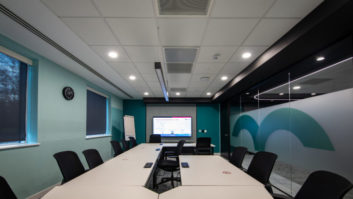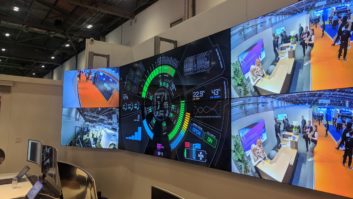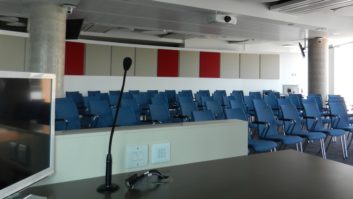As millennials have pushed their employers for access to the same level of technology that they have at home – so unified communications and collaboration in the workplace have become more sophisticated.
But the spend on office comms appears to be uneven. Recent research from Futuresource has suggested that only 21% of meeting room budget is spent on audio, compared with 46% on video. Is this due to the higher costs of visual equipment, or is something more fundamental going on? Could it be because audio has always been considered of secondary importance when compared with video?
“If you want to understand the importance of audio, just consider that you can close your eyes but you can’t close your ears!” says Christian Bozeat, director at consultants macom. “The old joke goes that AV stands for ‘All Video’, and audio is left out as it is a complex and difficult subject and many do not have the skills to do it correctly.”
Bozeat adds that it is imperative that a consultant with excellent audio knowledge and an acoustician are deployed before a project begins. “This ensures standards are in place, as it is too late to wait for a system integrator to be engaged and they are far too late to affect the design of a building by that stage in any case.”
“I certainly think that audio is neglected, and that video is still seen as the most important element of a meeting room setup because the screen tends to be the main focus of the room,” agrees Emma Bigg, director of Octavius RE consultants. “Also, I think AV integrators don’t always have in-house people who have a lot of experience in pro audio, and it has not been seen as a separate job to design the audio system but simply as an add-on to the video system. Importantly this is now changing and people are becoming more knowledgeable about audio and its importance.”
Audio realisationWhatever the reasons for the skewed expenditure, things do appear to be changing, with spend on audio on the increase – perhaps as a result of increased sophistication of the available comms-systems. There also seems to be a belated realisation among enterprises and their tech suppliers that good comms demands good audio – however surprising this delay in prioritising audio may seem.
“The awareness has risen that audio matters, and integrated solutions today cater to a much broader range of requirements when it comes to integration,” states Kai Tossing, portfolio manager business communication, Sennheiser. “Without audio, even the best video becomes useless in a conference call. When it comes to collaboration, both audio and video are crucial to create an immersive end user experience and to allow teamwork over distance.”
Approximately 80% of data transmitted during a meeting is over audio, so its importance certainly cannot be overstated.
“When there is high quality audio the meeting participants can communicate naturally as if they are in the same room, even when they are on different continents,” says James Hill, director, systems sales at Shure UK. “We are seeing high quality audio become much more of a priority as videoconferencing becomes increasingly pervasive in the workplace and users require a better experience.”
“Having the ability to talk to, and hear the other parties clearly during a meeting is absolutely vital, and will always remain so,” comments Pat Finlayson, senior product manager, Polycom. “Businesses that do not pay attention to their meeting room audio quality are putting themselves at risk. Simply because without good quality audio solutions they will be unable to communicate effectively with colleagues who are working in offices based at other sites, or those who are working remotely.”
Businesses, consultants and integrators are now taking a much more holistic approach to designing systems. This isn’t just about meeting rooms: they are considering the employee experience throughout the building and the role of AV in improving that user experience.
“With the entrance of millennials into the workplace, companies are having to up their game in terms of workplace technology and unified communications just to engage and retain younger staff,” says Bigg. “Good acoustics and good audio have a really important part to play in these solutions.”
Huddle up
At the same time, the trend towards collaboration in smaller meeting rooms and huddle spaces means that optimum performance and experience is expected to be delivered in more cost effective ways, with improved audio taking up some of the budgetary slack. It’s said to be even more difficult to integrate excellent audio in these smaller spaces.
“Instead of three to four large boardrooms, companies are deploying hundreds of smaller collaborative spaces that demand significantly lower implementation and management costs of technology,” says Shaun Robinson, VP of customers solutions, Harman Professional Solutions. “As a result, Harman solutions for this kind of space have been tailored as an all-in-one, simple to install and manage appliance versus an integrated system of components.”
As huddle rooms are popular and typically come in lots, budget restrictions often force compromises. At the same time, the push to huddle has also encouraged R&D.
Emma Bigg: “These smaller more intimate collaboration spaces have been a big driver in the development arc we have seen in audio products for UC. Compact, sometimes portable cost effective devices have been developed, or you see audio manufactures like Yamaha getting into the ‘meeting room in one box’ market.”
“Huddle rooms have definitely influenced a new category of audio solutions,” agrees Marc Happes, product manager for conferencing and unified communications at Bose Professional. “Products for these smaller spaces are tailored to fit the application and budget. However, when huddle room products are used in larger rooms — for which they weren’t designed — the audio experience is compromised.”
The reason for this is simple: participants in larger rooms are seated further away than microphone pick-up ranges can handle, and they’re too far away for the limited output of loudspeakers. “An installed audio system would still be appropriate in these larger rooms,” adds Happes. “It is important to use the right product for the application.”

Huddle spaces have certainly encouraged manufacturers to make scalable solutions to enable their products to be used throughout the UC ecosystem, and different scales of rooms with different use cases definitely require dedicated solutions.
“The huddle room is a prominent example of rooms in business environments. One or few people want to connect to the outside and seamlessly collaborate,” says Tossing. “Software and hardware solutions must cater for the requirements of the huddle room. Latest technology also caters to this demand, offering anything from affordable to highly and seamlessly integrated solutions with perfect interaction on an enterprise scale.”
Indeed, many available solutions are now compatible with a whole host of different working spaces, from desk right through to huddle spaces and large boardrooms – even the home office.
“By making solutions relevant for all environments, businesses can realise a much higher return on investment due to increased employee productivity,” explains Finlayson. “Work becomes more enjoyable and rewarding.”
Product development
Approaches to audio solutions in UC and collaboration environments have certainly evolved – and not just as a result of the rise of the huddle. “With the product development in this area from manufacturers such as Shure and Sennheiser, there are now a greater range of high quality products available,” states Bigg. “These products are more technologically advanced, network enabled and designed to integrate into corporate AV and UC solutions.”
New technologies allow for more flexibility and an improved user experience. Adaptive beamforming microphones make it possible to capture great audio from any speaking person, anywhere in a room. “Beamforming microphone arrays is an area of technology where we have seen the most evolution,” agrees Robinson. “However, continued enhancements in echo-cancellation and noise reduction are adding value as we go forward in enabling great audio around UC and collaboration.”
Hill explains: “Ceiling array microphones have enabled us to minimise ‘table noise’ to a certain extent, and with noise reduction, echo cancellation etc, audio within collaborative situations is much better and will continue to improve through technology.” Hill believes that, historically, people were prepared to put up with poor sound, but believes that’s changing as more people expect better audio. “As an increasing number of IT professionals become involved with AV, and we move to a world where more or less everything is on the network, we are evolving our products to meet these expectations.”
But as AV technology has proliferated commercial spaces, architectural trends have also evolved to focus on aesthetics, finishes, and furnishing: increasingly high tech also means high style. As a consequence, proper placement of speakers and microphones has become more of a challenge for integrators. “Fortunately, audio has been able to adapt to these architectural trends by creating products like ceiling speakers that can be installed along the perimeter of the room and low-profile ceiling microphone arrays,” explains Happes. “Other products like all-in-one sound bars have integrated microphones, speakers, cameras, and video connectivity, which means table tops have become less crowded with equipment. The user experience improves because the mics, speakers, and camera are positioned relative to the display – so meeting participants direct their attention toward the video participant instead of ‘talking at the table’.”
“Manufacturers have certainly developed products that more suit the needs of the user and are moving the microphones off the table into the ceiling and walls,” agrees Bozeat. “Beamforming microphones are a great advance, but even they can’t tackle being installed incorrectly or in rooms that are too large and have bad acoustics.”
Acoustics aspect
Acoustics of course are an extremely important component in any conferencing space, and this aspect of audio is perhaps the most neglected. Project budget constraints often limit the involvement of acoustical consultants – or at least dedicated ones. So, as a result of the added costs, acoustic treatments and remedies are often not considered or are abandoned.
“Acoustics is massively important!” says Bozeat. “There is still a big gap in understanding the architectural and construction issues around room design of the modern working environment. It takes a lot of effort and it is still challenging, and aesthetics often win the battle over physics at the expense of audio quality in larger spaces.”
“Thou shalt not neglect physics!” agrees Tossing. “Even with most advanced algorithms and high-tech equipment, the rules of physics still apply. Technology can improve compromises and allow product use cases that were not recommendable in the past – such as in-ceiling microphones. But, the better rooms are treated acoustically, the easier the system integration will be, and moreover, it will allow for a broader choice of solutions.”
Hill continues: “It’s hugely important and unfortunately still a neglected area. I often visit customers who are trying to get the best sound out of a space only to find there are four glass walls, hardwood floor and a huge air-handling unit in the corner. We can do some amazing things with our microphones and DSP, but to get the best results possible, acoustics definitely come into play.”
Enclosed huddle spaces with highly reflective surfaces such as glass are a huge challenge. However, it isn’t just about reducing echoes or environmental background noises: acoustics are also about ensuring the privacy of the meeting. “Background noise can create significant, ongoing distractions in any meeting space – for both in-room and remote participants,” says Happes. “Audio algorithms have helped to mitigate background noise on conference calls, but there is still room for improvement.”
However, although still a relatively neglected area, acoustics is increasingly being seen as an essential part of the AV-in-UC narrative. “It has certainly been a neglected area in the past, but not currently,” confirms Bigg. “The proliferation of open plan or flexible working spaces have really shown end users, designers, architects and consultants how important acoustics are. Addressing the acoustic environment is now understood to be as important as the design and flow of a space.”
“Many businesses understand the important role that acoustics play during a meeting,” adds Finlayson. “One of our customers, for instance, was acutely aware of the impact that poor acoustics would have on communications and wanted to eliminate any issues that would cause.”
Ultimately, collaboration technology makes it possible to connect a global workforce in today’s agile workplace environments, and audio is an essential, sometimes neglected, part of that exchange.
As unified comms technology has evolved and commercial AV space design has evolved with the tech, so the care and attention shown to the often-overlooked audio component of AV-for-UC has begun to – rightly – increase.
Happes: “When the spoken word is intelligible and coverage is uniform, meeting participants remain engaged from wherever they are located.”
https://pro.bose.com
https://pro.harman.com
www.macom.de/en
www.polycom.com
www.sennheiser.com
www.shure.com







